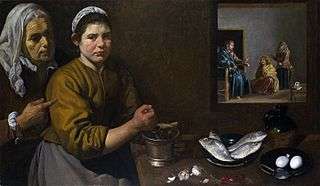Jesus at the home of Martha and Mary
Jesus at the home of Martha and Mary (also referred to as Christ in the House of Martha and by other variant names) refers to a Biblical episode in the life of Jesus which appears only in Luke's Gospel (Luke 10:38–42), and can be read immediately after the Parable of the Good Samaritan (Luke 10:25–37).[1] Jesus visits the home of Lazarus, Martha and Mary of Bethany,[2] the latter typically conflated in Catholic medieval tradition with Mary Magdalene, though the New Testament probably means a different person.

Gospel of Luke
_Christus_im_Hause_der_Martha.jpg)
According to the Gospel of Luke:
As Jesus and his disciples were on their way, he came to a village where a woman named Martha opened her home to him. She had a sister called Mary, who sat at the Lord's feet listening to what he said. But Martha was distracted by all the preparations that had to be made. She came to him and asked, "Lord, don't you care that my sister has left me to do the work by myself? Tell her to help me!" "Martha, Martha," the Lord answered, "you are worried and upset about many things, but only one thing is needed. Mary has chosen what is better, and it will not be taken away from her."
Interpretation
Mary chose listening to the teachings of Jesus over helping her sister prepare food. Jesus responded that she was right because only one thing is needed, "one thing" apparently meaning listening to the teachings of Jesus. This goes in line with words by Jesus that Man shall not live by bread alone, but by every word of God (Matthew 4:4), and The words that I speak to you are spirit, and they are life, meaning eternal life John 6:63.[3] To simplify, this is frequently interpreted as spiritual values being more important than material business, such as preparation of food. Martha represents the anxious life associated with materiality.[4] Two different verbs describe her distress, “worry” and “distract,” and Luke doubles her name and uses alliteration to draw attention to her anxious behavior (Greek: Μάρθα Μάρθα μεριμνᾷς, Martha, Martha, merimnas in Luke 10:41).
Depictions in art
The episode is mostly found in art from the Counter-Reformation onwards, especially in the 17th century, when the domestic setting is usually given a realistic depiction, and the subject appears as a single work rather than in cycles of the Life of Christ, or the life of Mary Magdalene. However, it appears in some Ottonian manuscript cycles, including the one in the Pericopes of Henry II (c. 1002–1012), where it is given a hieratic architectural setting. Many paintings show Mary washing, or just having washed, Jesus's feet, recalling the story in John 12.1–8 (which seems to be about Mary of Bethany). Via the story in Luke 7.36–50 (about an unnamed 'sinful woman'), however, Mary of Bethany was often conflated with Mary Magdalene, and this too may be reflected in art.[5] Artists depicting the subject include Diego Velázquez, Rembrandt, Jan Vermeer, Caravaggio and Rubens.
Individual works with articles include:
- Christ in the House of Martha and Mary – an early work by the Spanish painter Velázquez
- Christ in the House of Martha and Mary – by Johannes Vermeer
- Martha and Mary Magdalene – Caravaggio
Depiction in Literature
Rudyard Kipling's poem The Sons of Martha, Kipling defends people who dedicate themselves to work like Martha.
In his book The Doors of Perception, Aldous Huxley alludes to the story of Mary and Martha, addressing the distinction between what he terms "the way of Mary" and "the way of Martha." Huxley notes that, during his experiences with mescaline, time seems to stand still, and contemplation--the way of Mary--rules the day. Quotidian cares fall to the wayside. In one passage, Huxley writes, “Mescalin opens up the way of Mary, but shuts the door on that of Martha.”
In the novel Time Enough For Love by Robert A. Heinlein, the character Minerva says, "I am a Martha, Lazarus, not her sister Mary." This, as a response to another character's attempt to describe her appearance, is a testament to her pride in being practically minded.
In the novel, The Handmaid's Tale, by Margaret Atwood, the women servants of the dystopian society (doing the cooking and cleaning) are called, "marthas."
See also
- Gospel harmony
- List of names for the Biblical nameless
- Women in the Bible
| Wikimedia Commons has media related to Martha and Mary. |
References
Notes
Citations
- Tyson 1998, p. 271.
- Mills 1990, p. 507.
- Aust 1999.
- Resseguie 2004, p. 85.
- Schiller 1971, p. 158–159.
Sources
- Aust, Jerold (5 December 1999). "Profiles of Faith: Mary & Martha - Lessons from Two Sisters". United Church of God. Retrieved 30 July 2020.CS1 maint: ref=harv (link)
- Mills, Watson E., ed. (1990). Mercer Dictionary of the Bible. Mercer University Press. ISBN 978-0-86554-373-7.CS1 maint: ref=harv (link)
- Resseguie, James L. (2004). Spiritual Landscape: Images of the Spiritual Life in the Gospel of Luke. Hendrickson. ISBN 978-1-56563-827-3.CS1 maint: ref=harv (link)
- Schiller, Gertrud (1971). Iconography of Christian Art. Volume 1: Christ's Incarnation. Childhood. Baptism. Temptation. Transfiguration. Works and miracles. Lund Humphries.CS1 maint: ref=harv (link)
- Tyson, Joseph B. (1998). Literary Studies in Luke-Acts: Essays in Honor of Joseph B. Tyson. Mercer University Press. ISBN 978-0-86554-563-2.CS1 maint: ref=harv (link)
